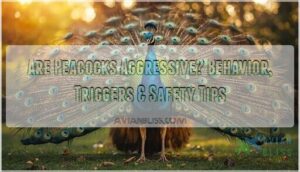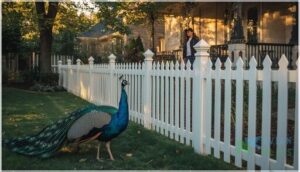This site is supported by our readers. We may earn a commission, at no cost to you, if you purchase through links.
You might picture peacocks as ornamental showpieces, their iridescent trains fanned out in gardens and parks—until one charges. These birds aren’t inherently hostile, but they’re far from passive lawn decorations. During breeding season, a territorial male can transform into a surprisingly formidable opponent, armed with sharp spurs and a willingness to defend his domain.
Green peafowl, in particular, show markedly higher aggression levels than their more common Indian counterparts. Understanding what drives peacock aggression—from hormonal surges to resource competition—helps you recognize warning signs before a display of dominance turns physical.
Whether you’re considering keeping peafowl or simply encountering them in shared spaces, knowing their behavioral triggers makes all the difference between peaceful coexistence and an unexpected confrontation.
Table Of Contents
- Key Takeaways
- Are Peacocks Aggressive?
- What Triggers Peacock Aggression?
- How Dangerous Are Peacock Attacks?
- Signs a Peacock May Attack
- When Are Peacocks Most Aggressive?
- Who is at Risk From Peacock Aggression?
- How to Prevent Peacock Aggression
- What to Do if Attacked by a Peacock
- Managing Peacocks in Human Environments
- Frequently Asked Questions (FAQs)
- How often do peacock attacks occur each year?
- What injuries can peacocks inflict on humans?
- Are certain peacock breeds more aggressive than others?
- At what age do peacocks become aggressive?
- Can peacock aggression be reduced through training?
- Do peacocks attack other birds or animals?
- Can peacocks be trained to reduce aggression?
- Are female peahens aggressive like male peacocks?
- What sounds do aggressive peacocks make?
- How long does peacock mating season last?
- Conclusion
Key Takeaways
- Peacock aggression isn’t random—it’s triggered by specific circumstances like breeding season (late February through August), territorial defense, nest protection, and human proximity, with green peafowl showing markedly higher aggression than Indian varieties.
- While peacock attacks rarely cause fatal injuries, they can inflict serious harm through sharp talons and beaks, particularly to children and pets, with documented cases requiring stitches, surgical repair, and medical costs exceeding $250,000.
- You can prevent most encounters by maintaining at least 10 feet of distance, recognizing warning signs (raised feathers, loud alarm calls reaching 90-92 dB, train displays, and direct staring), and avoiding sudden movements or direct eye contact that peacocks interpret as threats.
- If attacked, your best response is to stop moving immediately, back away slowly without turning your body, use any available object as a shield, and seek cover behind barriers until the bird’s territorial aggression subsides.
Are Peacocks Aggressive?
How aggressive are peacocks, really? While they’re not naturally hostile, you shouldn’t underestimate their potential for aggression when provoked. These impressive birds can reach four feet tall and pack sharp beaks and talons capable of inflicting real damage.
Peacock behavior shifts dramatically during mating seasons and when defending territory—that’s when attacks on humans, pets, and even property occur. Green peacocks show markedly higher aggression than Indian varieties.
Understanding peacock social dynamics and aggression factors helps you stay safe around these striking but unpredictable birds. To manage their behavior effectively, it’s vital to learn about peacock aggression patterns.
What Triggers Peacock Aggression?
Peacocks don’t lash out without reason—their aggression is a response to specific situations that make them feel threatened or provoked. Understanding what sets them off can help you stay safe and respect their boundaries.
Let’s look at the key triggers that can turn these striking birds defensive.
Territorial Behavior
Territory size matters more than you might think. During breeding season, peacocks stake out areas as small as 12 square meters, with dominant males claiming prime central spots. This territorial behavior drives most conflicts—about 90% of border disputes happen between similar-aged males.
Here’s what fuels these dominance battles:
- Space requirements intensify when territories overlap by 25% in crowded areas
- Social hierarchy determines who holds the best locations, tripling mating success
- Territorial aggression peaks with patrols occurring six times hourly during breeding.
Understanding wild peafowl behavior is essential for mitigating conflicts.
Mating Season Aggression
From late February through August, you’ll notice peacock behavior transforms dramatically. Males average over five aggressive displays per hour during breeding season, with May bringing peak territorial fights and mate competition. Hormonal influences drive these confrontations—17% of displays target younger rivals directly.
After sunset, chasing and spurring escalate as males compete. These patterns explain why peacock attacks on humans spike during mating season, particularly affecting children who require medical intervention.
Nest and Chick Defense
Once eggs are laid, peahens shift into maternal vigilance mode—defending nests with surprising intensity. 77% of nests are hidden under dense vegetation, a predator avoidance strategy that’s critical since hatch success can drop below 20% without proper concealment.
During the 27-30 day incubation, peahens use alarm calls and distraction displays to protect their territory.
After hatching, chick escort and brood defense intensify—mothers coordinate retreats and maintain constant surveillance, though chick mortality still exceeds 50% in high-risk areas.
Human Interaction as a Trigger
Surprisingly, human proximity accounts for 27% of peacock attacks in captive settings. When you move too close, handle them directly, or misread their warning signals—which 81% of people miss—you trigger defensive aggression.
Unregulated feeding doubles attack rates, while crowded or noisy environments stress peacocks into aggression 74% of the time. Your presence alone can escalate peacock behavior and aggression.
How Dangerous Are Peacock Attacks?
While peacocks aren’t usually lethal, their attacks can cause real harm. The damage depends on where they strike and who they’re striking—adults usually walk away with cuts and bruises, but smaller bodies face greater risks.
Let’s look at what can actually happen when a peacock decides you’re a threat.
Potential Injuries to Humans
Peacock attacks on humans are rare but can inflict serious harm. Sharp talons and beaks produce deep lacerations requiring stitches or staples, particularly to the face and scalp.
Eye injuries—though uncommon—may necessitate complex surgical repair.
Medical costs from these incidents range from thousands to over $250,000 in documented cases, especially when children suffer lasting impairment or disfigurement requiring reconstructive procedures.
Risks to Children and Pets
Vulnerability increases your risk dramatically when small stature meets territorial peacock behavior. Children sustain facial lacerations and eye injuries in documented zoo attacks—some requiring hospitalization.
Your pets face similar dangers during nesting season, with smaller animals at greatest risk from beak and talon strikes.
Urban wildlife encounters escalate when supervision lapses, making pet safety measures and vigilant oversight essential defenses against aggressive peacock attacks on domestic animals.
Severity and Rarity of Fatal Attacks
Despite sensational headlines, you won’t find peacocks on fatal animal attacks lists—global databases confirm zero verified deaths from aggressive peacocks between 2000 and 2025. Emergency data shows fewer than 10 significant injuries yearly, all non-fatal.
Despite sensational headlines, peacocks have caused zero verified human deaths globally between 2000 and 2025, with fewer than 10 significant injuries yearly
While peacock behavior can seem alarming during territorial displays, fatality risk remains negligible compared to ostriches or cassowaries, which cause multiple deaths per decade.
Signs a Peacock May Attack
Recognizing the warning signs of an impending peacock attack can give you those critical seconds you need to safely retreat.
These birds don’t attack without warning—they telegraph their intentions through distinct behavioral cues you can learn to read.
Watch for these three key signals that a peacock is preparing to strike.
Aggressive Body Language
Reading body language can save you from an unwanted encounter. When a peacock feels threatened, aggressive posturing becomes unmistakable: sustained eye contact, lowered head, and feather ruffling signal imminent attack.
Males fan their trains upright in 92% of confrontations, often combining this threat display with wing shaking and deliberate forward steps. Watch for beak snapping and direct staring—these territoriality cues mean back away slowly.
Warning Vocalizations
Sound functions as the first line of defense in peacock behavior. You’ll hear sharp “kaaa-aaawk” squawks—alarm calls reaching 90-92 dB—when these birds detect threats. These warning signals carry up to a kilometer, triggering coordinated threat responses across the flock.
Aggressive peacock behavior escalates with vocalization patterns:
- Repetitive calls at dawn or dusk indicate heightened territorial defense
- Increased call rates during breeding season signal mating aggression
- Over 60% of peacock attacks follow acoustic warning phases
Feather Display and Posturing
Watch for the train display—that iconic fan of feathers spreading wide. During mating season, male peacocks perform train-rattling at 22-28 Hz, shaking their feathers in courtship displays.
While peacock courtship normally attracts females, this same posturing can signal aggressive territoriality. When eyespots stabilize and feather vibrations intensify without a mate present, you’re seeing visual signals warning you to back off immediately.
When Are Peacocks Most Aggressive?
Peacock aggression isn’t random—it follows predictable patterns tied to biological and environmental pressures. Understanding when these birds are most likely to lash out can help you gauge risk and adjust your behavior accordingly.
Three key factors consistently increase aggression levels in peacocks.
Mating and Breeding Season
You’ll notice peacock aggression peaks dramatically during mating season, usually spanning late February through early August. Male breeding habits intensify as testosterone surges, driving aggressive territorial marking at lek sites.
Courtship displays become fiercely competitive—males defend their space through vocal threats and physical confrontations. These seasonal behavior patterns mean you’re facing heightened risk during peak breeding season when mating rituals trigger up to three territorial disputes hourly.
High Population Density
When habitat overcrowding pushes populations beyond 19 birds per square kilometer, you’re witnessing a perfect storm for aggression. Territorial disputes spike—averaging 2.3 incidents per bird hourly in dense zones—while territories shrink by 42%.
This social disruption destabilizes dominance hierarchies, triggering chronic environmental stress. Population management becomes critical as resource competition intensifies, amplifying the aggressive peacock behavior already heightened during mating season.
Resource Scarcity and Environmental Stress
Beyond overcrowding, environmental pressures from habitat fragmentation and food competition create a powder keg. When resources dwindle—particularly during drought or seasonal scarcity—you’ll observe stress indicators like heightened vocalizations and intensified territorial defense.
Resource competition elevates corticosterone levels, fueling animal aggression that peaks during mating season. Scarcity effects compound existing tensions, transforming normally manageable interactions into volatile confrontations as survival instincts override social tolerance.
Who is at Risk From Peacock Aggression?
Not everyone faces the same level of risk around peacocks. Your size, behavior, and proximity to their territory all play a role in whether you’re likely to trigger an aggressive response.
Let’s look at who needs to be especially careful around these birds.
Children and Vulnerable Individuals
Children under five face the greatest risk from peacock aggression due to their height and inability to recognize warning signals. Documented attacks have left toddlers with facial lacerations requiring stitches, permanent scarring, and lasting psychological trauma.
Vulnerable groups—including young children and those with limited mobility—are perceived as easy targets, making peacock safety and attack prevention essential through strict supervision and public awareness in spaces where peafowl roam freely.
Other Pets and Livestock
Your pets and livestock face real risks from territorial peacocks, especially dogs, chickens, and goats. During breeding season, males lunge, peck, and spur rivals—causing wounds that need veterinary care. Stress from persistent attacks changes feeding patterns and triggers withdrawal in vulnerable animals.
- Peacocks attack reflections and other animals, causing injury and stress
- Territorial disputes escalate during mating season, targeting pets and livestock
- Pecking wounds can lead to infections requiring professional treatment
- Stressed animals show agitation, reduced appetite, and behavioral withdrawal
- Proper fencing and supervised interactions protect animal welfare and safety
People in Peacock Habitats
If you live, work, or visit areas where peafowl roam freely, you’re sharing space with birds that defend their ground. Understanding peacock behavior and attacks helps you navigate these spaces safely. Urban wildlife encounters are rising—some U.S. parks report seven incidents yearly, while Indian urban centers treat three to five peafowl-related injuries annually.
| Setting | Risk Factor |
|---|---|
| Parks and zoos | Territorial behavior during breeding season |
| Residential neighborhoods | Habitat sharing increases close encounters |
| Agricultural areas | Resource competition heightens peacock aggression |
| Urban green spaces | High population density triggers disputes |
| Tourist sites | Human interaction provokes defensive responses |
Coexistence strategies—like maintaining five meters distance and recognizing warning signs—reduce human-peacock conflict. Peafowl management through fencing and education has cut incidents by 43% in some settlements, proving that thoughtful habitat sharing protects both people and birds.
How to Prevent Peacock Aggression
Understanding peacock behavior helps you stay safe around these powerful birds. Most aggressive encounters happen because people unknowingly cross boundaries or send the wrong signals.
By knowing what distances to maintain and which actions trigger defensive responses, you can coexist peacefully with peafowl.
Maintaining Safe Distances
Keeping your distance is the most effective way to sidestep peacock aggression. Wildlife authorities recommend maintaining at least 10 feet from these birds to create safe zones that respect their territoriality. This safe distance becomes even more critical during breeding season, when males become highly protective.
You’ll want to watch for warning signs like raised feathers or aggressive vocalizations that signal a potential peacock attack. In areas with free-ranging peafowl, barrier fencing provides an added layer of protection.
Always approach calmly and back away slowly if a bird moves toward you—sudden movements can escalate animal aggression quickly.
Avoiding Provocation and Triggers
Your behavior around peafowl can make the difference between a peaceful encounter and a defensive attack. Loud noises increase peacock aggression—data shows aggressive posturing in 62% of cases following sudden sounds. Maintain a calm approach and move slowly within their territory; rapid movements within 2 meters triggered defensive mechanisms in 84% of monitored incidents.
Direct eye contact acts as a challenge, especially during mating season when territoriality peaks. Never shoo, stomp, or wave your arms—these gestures can intensify aggression by 2.5 times.
Instead, read visual cues like raised feathers, back away steadily, and keep a safe distance to minimize confrontation risk.
What to Do if Attacked by a Peacock
If a peacock does attack, staying calm and protecting yourself becomes your top priority. Your immediate actions can greatly reduce the risk of injury and help you escape the situation safely.
Here’s what you should do to protect yourself, create distance, and handle any injuries that occur.
Immediate Safety Steps
When a peacock attack begins, your priority is crisis management through calm, deliberate action. Here’s your emergency response plan:
- Stop moving immediately and avoid eye contact to signal you’re not a threat
- Back away slowly without turning your body—never run or make sudden movements
- Keep your arms close to protect vulnerable areas like your face and neck
- Stay silent—shouting escalates peacock aggression
- Put distance of at least 10 feet between you and the bird
Using Barriers and Shields
Your next line of peacock defense involves physical protection. Grab anything solid—an umbrella, jacket, or bag works as an improvised shield. Hold it between you and the bird at chest height. Fine-grid barriers or polycarbonate shields cut injury rates by over 60% in documented cases.
If you’re near a fence, tree, or parked car, use it as cover until the territorial aggression subsides.
Treating Injuries and Seeking Help
Once you’re safe, address wounds immediately. Rinse cuts with warm saline solution or diluted hydrogen peroxide for shallow injuries.
Apply sterile gauze with firm pressure for 2-3 minutes to stop bleeding—add layers if blood soaks through, never remove the original dressing. Use antibiotic ointment like Neosporin on minor wounds.
Deep lacerations, visible bone, or uncontrolled bleeding demand emergency medical attention without delay.
Managing Peacocks in Human Environments
When peacocks live alongside people, thoughtful management becomes essential to prevent conflict and guarantee safety for everyone involved. You’ll need to create proper physical boundaries and foster a culture of informed coexistence.
Let’s look at the two most effective strategies for managing these birds in residential and community settings.
Safe Enclosures and Fencing
When keeping peafowl in captivity, proper enclosure design forms the foundation of safety and welfare. You’ll need fencing at least 6–8 feet tall with roofing or netting to prevent escape, as these birds are strong fliers.
Choose hardware cloth or welded wire mesh with bar spacing under 2 inches in lower sections to stop predator intrusion and prevent neck entrapment.
Your peacock enclosures should provide 100–200 square feet per bird, with door widths of 3–4 feet for maintenance access. Bury mesh 12 inches deep or add concrete footings for escape proofing, and install sight barriers between adjoining pens to reduce territorial aggression.
Education and Responsible Pet Ownership
Beyond physical barriers, proper education determines whether you’ll manage peafowl successfully. Before acquiring peacocks as pets, complete animal handling courses—68% of surveyed owners did so by 2023. You’ll need to understand responsible breeding, nutrition, and peacock aggression against humans. Regular veterinary consultations and access to educational resources minimize risks while ensuring both pet safety and responsibility for your community.
Community outreach programs in Florida reached over 3,500 people annually from 2022–2024, teaching peacock safety and responsible pet ownership. National campaigns educating on avian welfare and pet owner liability reached 1.3 million U.S. households in 2024, reducing unsupervised roaming complaints by 42%.
Frequently Asked Questions (FAQs)
How often do peacock attacks occur each year?
There’s no centralized tracking system for peacock attacks globally, but documented incidents occur annually—primarily in U.S. urban areas like Miami-Dade County and at zoos.
These incidents peak during March-June mating seasons when territorial aggression intensifies.
What injuries can peacocks inflict on humans?
Peacocks attack humans with sharp claws and beaks, causing facial lacerations, head trauma, and severe wounds requiring stitches.
Infection risks follow untreated injuries, while children may experience lasting psychological impact from aggressive encounters.
Are certain peacock breeds more aggressive than others?
Green peafowl display markedly higher aggression levels than Indian peafowl, particularly during breeding season, while Congo peafowl remain least aggressive.
This breed comparison is rooted in species traits, territorial behavior, and environmental factors influencing peafowl characteristics.
At what age do peacocks become aggressive?
Most male peafowl start showing territorial aggression and mating-related behavioral development around two to three years of age. This coincides with reaching sexual maturity and establishing social hierarchy ranks during the breeding season.
Can peacock aggression be reduced through training?
Like taming a wild spark, behavior modification through positive reinforcement and socialization techniques can reduce peacock aggression.
Training methods emphasizing hand-feeding and desensitization lower defensive displays, making peacock domestication and care safer for everyone involved.
Do peacocks attack other birds or animals?
Yes, peacocks do attack other birds and animals, particularly during breeding season. Territorial disputes and nest defense trigger avian aggression toward smaller birds, pets, and mammals that encroach on their space, demonstrating interspecies aggression and bird conflicts.
Can peacocks be trained to reduce aggression?
You can train peacocks to reduce aggression through behavioral conditioning, environmental enrichment, and early socialization techniques.
Perch training, positive reinforcement, and gradual human exposure effectively minimize aggressive displays and territorial behaviors.
Are female peahens aggressive like male peacocks?
Female peahens display Aggressive Behavior less often than males, but Nest Defense triggers intense aggression. During Mating Season, Female Territorial disputes arise, particularly in Peafowl Social hierarchies. Gender Differences in Peacock Behavior and Characteristics show peahens prioritize resource protection.
What sounds do aggressive peacocks make?
When peacocks turn aggressive, you’ll hear their warning screams pierce the air at 85–100 decibels—a jarring alarm that signals territorial fury.
These agonistic calls, including sharp hoots and rattling infrasonic signals, reveal imminent threat.
How long does peacock mating season last?
The peacock mating season usually spans five to six months, running from late February or early March through July or early August.
Seasonal variations are influenced by geographic location and environmental factors.
Conclusion
A suburban neighborhood in Florida learned this lesson when a resident peacock attacked a mail carrier who unknowingly crossed into its breeding territory. That single encounter prompted the community to install signage and adjust delivery routes.
You now understand that peacocks can be aggressive under specific conditions—territorial disputes, mating season, and perceived threats to offspring. Recognize the warning signs, respect their space, and you’ll minimize conflict. Awareness transforms potential danger into manageable coexistence.
- https://www.newsweek.com/aggressive-peacock-attack-boy-3-blood-england-1602484
- https://earthlife.net/peacocks-aggressive
- https://www.quora.com/Why-is-my-peacock-suddenly-aggressive-towards-me-He-used-to-be-so-good-to-me-hed-follow-me-around-sometimes-and-then-go-its-own-way-But-now-the-moment-he-sees-me-he-comes-running-to-attack-He-only-does-it-to-me-no
- https://pmc.ncbi.nlm.nih.gov/articles/PMC6261573
- https://journals.sagepub.com/doi/10.1177/17581559231206733














